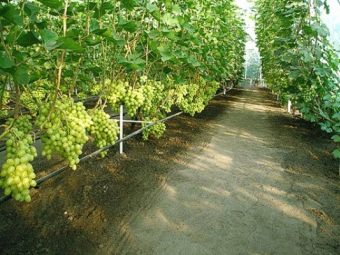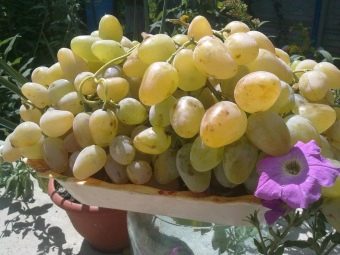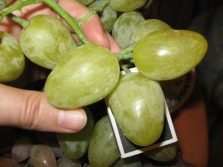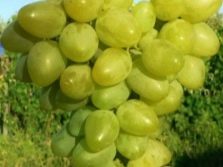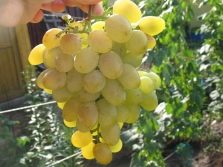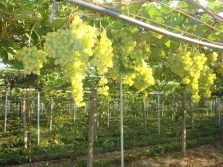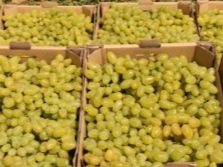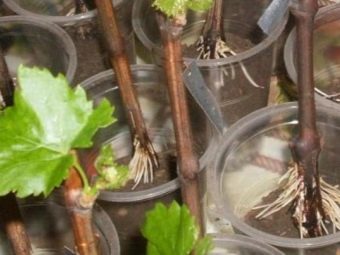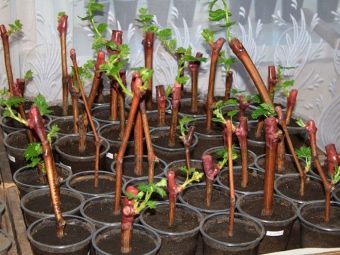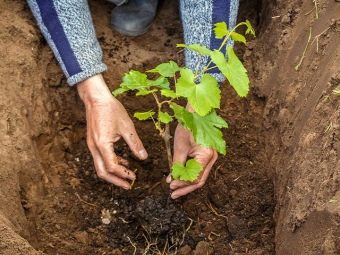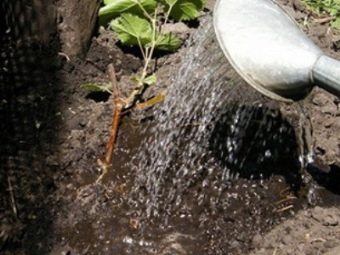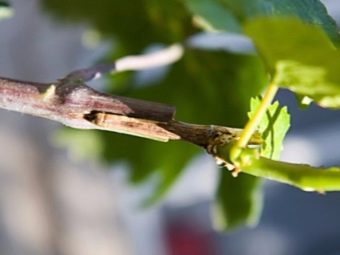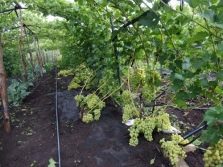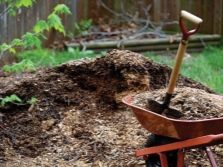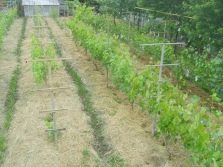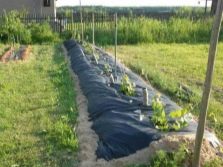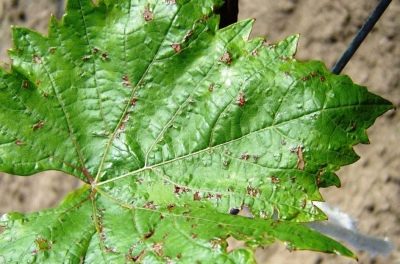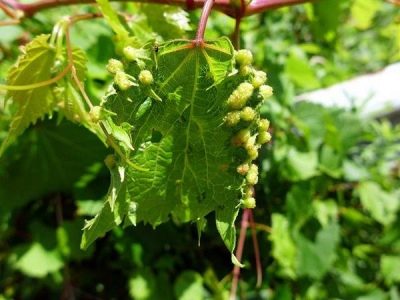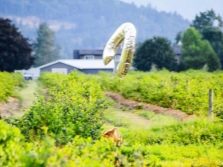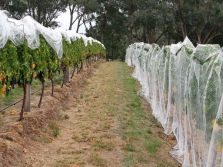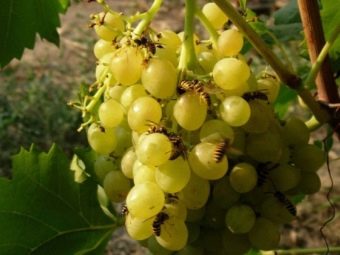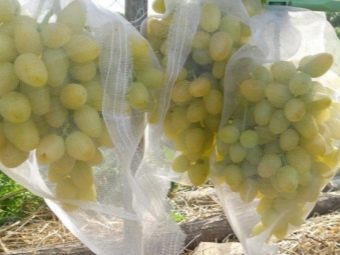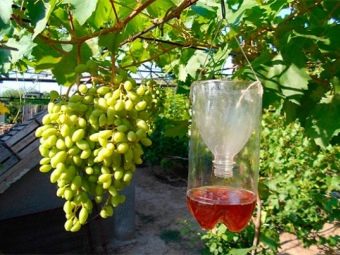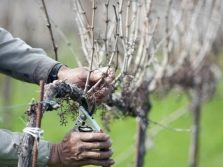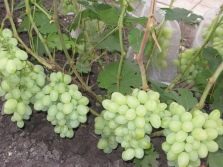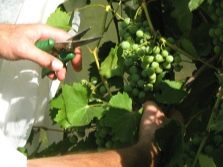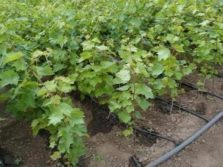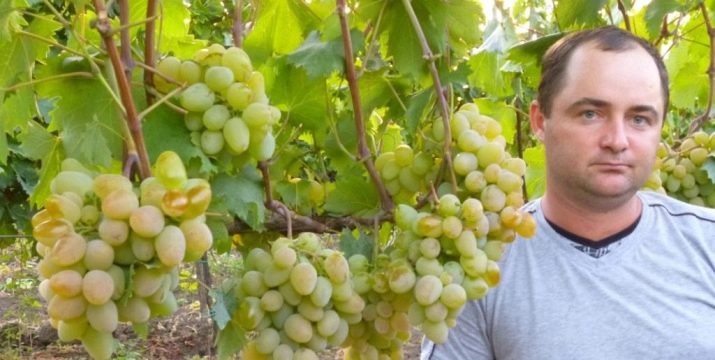Monarch grapes: characteristics and cultivation of the variety
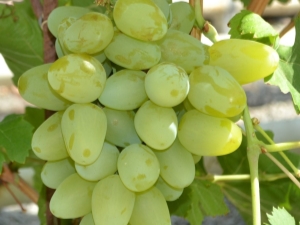
Wine growing is one of the most ancient branches of agriculture, aimed at the selection and cultivation of table and technical grape varieties to provide residents of different countries with this type of product.
For many decades, breeders have developed a large number of varieties of this crop, having their own individual characteristics and characteristics. Particular attention should be paid to the grapes "Monarch". This type deserves the attention of not only beginner gardeners, but also experienced ones.The main advantage of the variety is the possibility of obtaining large berries without additional care on medium-sized clusters.
The variety "Monarch" allows to obtain decent yields not only in areas of industrial cultivation, but also in small areas of household plots.
Special features
Monarch grapes are a type of table grapes, bred by Russian breeders of Pavlovsky Evgeny Georgievich by crossing two varieties - the German "Cardinal" and the Russian "Talisman". This variety is a universal basis for the breeding of improved technical and wine grape varieties.
The maximum mass of one bunch can reach 1000 g, the density of brushes on the vine is average, the bunch has the shape of a cone or cylinder. The berries of this variety are juicy and fleshy and have a weight of from 10 to 35 g. The number of seeds in one fruit does not exceed 4 pieces. The short period of ripening due to the presence of a large amount of sugars in the juice of this plant. "Monarch" - a variety with an average ripening period, the growing season ranges from 110 to 125 days.
The variety "Monarch" has a high percentage of ripening of the crop, one bush is able to produce at least 8 kg of fruit.
For more ovaries, the bushes should be planted in sunny places, as the plant belongs to the group of self-pollinated species.
This variety is high-yielding and early, but the amount of the crop and the time of ripening depend on several factors:
- growing region;
- climatic features of the area;
- weather.
The standard cycle lasts about four months.
Advantages and disadvantages
Connoisseurs of grapes note a number of indisputable advantages of this variety:
- aesthetic appeal of grape bunches;
- Muscat flavor aromatic, juicy and fleshy berries;
- no shedding of fruits during a long stay on the vine;
- resistance to sudden changes in temperature, high humidity and negative environmental influences;
- resistance of fruits to rotting;
- high density of the skin protects the fruit from wasps and other insects;
- long storage period;
- transportability;
- excellent presentation;
- high demand among consumers;
- high yield;
- resistance of vines to low temperatures in winter.
Disadvantages:
- shedding of the ovary in thinned vineyards;
- low mildew resistance.
How to plant?
The most favorable period for planting seedlings is the first month of spring, for grafting - spring and autumn.
For the cultivation and cultivation of healthy and strong vines must be attentive to the choice and purchase of cuttings. Seedlings should have a number of features:
- strong and developed root system;
- the color of the roots and its branches is only white;
- cut color - green;
- on the seedling should be at least four buds.
Before planting, seedlings should be left in water or damp ground until new roots and young leaves appear.
For the full development of plants in the nursery and high-quality ripening of the entire crop, the vines should be planted in sunny places, protected from wind and draft.
The soil in the field of planting grapes should be light, nutritious, loose and moist, black soil - ideal. The soil of clay and sand will be an obstacle to the full development and fruiting of the bushes. Groundwater should be at a depth of 2 meters from the grapes.
The depth of the planting pit should be twice the root of the cutting system. At the bottom of the pit lay a layer of humus or compost and pour an additional layer of simple soil. The prepared seedling should be carefully lowered into the hole, taking care not to bury parts of the root collar, and to carefully fill the root system with the soil, without damaging it. Attach a sapling to the installed support and pour it abundantly with water, the volume of which should not be less than 20 liters.
Before grafting the cuttings, they are pruned, leaving at least two hangers on each side. Cut seedlings put in the water for 24 hours. The shafts must be cleaned of the old bark of garbage and dirt, split stock in the center and put a cutting in it. Tie strap securely with a rope and cover it with a solution of clay.
Care
Competent and timely care - a pledge of obtaining a large number of crops from healthy and strong vines. Improper care of the vines in the nursery can lead to the collection of a small amount of poor-quality crops, illness and the death of the bushes.
The process of caring for the vineyard includes several steps:
- watering;
- fertilizer and mineral elements;
- pruning;
- cover and frost protection;
- treatment of diseases and dangerous pests.
Watering the vines is carried out twice - before the formation of flowers and at the time of fruit set. For regions with dry climates and low precipitation, this procedure should be carried out as the soil dries. Experienced gardeners install a drip irrigation system on their plots, which greatly facilitates this time-consuming process.
To preserve moisture and nutrition of the root system, mulching should be carried out with rotary humus. The thickness of the layer should not exceed 5 cm. Feeding the grapes "Monarch" is carried out with complex fertilizers containing potassium and phosphorus. The application of a small amount of fertilizers is carried out in the period of loosening the soil, followed by abundant irrigation.
In early spring after the opening of the nursery, the soil under the vines must be dried, thorough loosening and fertilizing with mineral fertilizers. Subsequent fertilizer should be carried out every 14 days. Weeding the soil is carried out all spring and summer, and watering is stopped at the stage of the formation of the fruit.
In regions with low temperatures in winter, it is imperative to cover the grapes cut and prepared for wintering, bending them to the ground and covering them with hay and film. In areas with warm and temperate climates, this procedure can be omitted.
For the prevention of possible damage to the bushes of grapes by different types of diseases, experienced gardeners advise regularly to carry out the treatment with special chemical and organic preparations or Bordeaux mixture. Processing nursery carried out in the morning or evening with no precipitation and wind. The spraying is carried out with a special irrigation device, which disperses the preparations only on the grape vines. Standard treatment includes applying three times special formulations to plants.
Professional gardeners emit several types of diseases.
- Anthracnose (grape pruritus) - a dangerous fungal disease. The first signs are the appearance of gray spots on the leaves. After a short time there is a lesion of the grape stem, the formation of brown spots on the central part of the vine and its shoots. Infected bushes dry out and become brittle. Berries change their shape and lose skin strength.
- Phylloxera - a cunning and hidden kind of disease, in which aphid appears on the roots and leaves. Plants planted in sandy soil, do not get sick with this disease. On the shelves of specialized stores you can find a wide range of drugs for the prevention and treatment of this disease, and experienced consultants will help you purchase the right product.
To obtain a quality crop, experienced gardeners advise to pay attention to the birds that are present at or near the site. Even a small number of birds can harm the ripening of fruits and significantly reduce their quality. To scare away birds, bright and colorful objects should be placed on their territory, and bunches should be placed in special non-woven mesh bags.
Modern manufacturers offer a new type of protective devices - sound scarers.
Wasps and bees cause the greatest harm to ripe berries. They not only spoil the presentation of the fruit, but also destroy the berries, drinking all the grape juice. There are several ways to combat this type of insect:
- search for wasp nests with subsequent treatment with toxic chemicals;
- timely collection of damaged fruit;
- placing grape brushes in special mesh bags that prevent the penetration of insects to ripe fruit.
To fight wasps, it is strictly forbidden to use chemicals in connection with the ingestion of poisons on ripe fruits. Traps are an effective way to preserve the harvest. The availability and safety of this method allows you to save the crop without the use of financial costs.
You can use different types of traps.
- Plastic bottle with sweet and fragrant water, compote or syrup. The installation of these traps is carried out not only in summer, but also in spring.
- Industrial catchers for wasps.
Filler for baits can serve as stale meat and fish.
If a large number of pests appear, poisonous chemicals can be added to the syrup.
Tips
Among the large number of positive reviews about this variety it is necessary to highlight the main drawback - the shedding of fruits. In order to avoid this situation, Pavlovsky E. G. advises to follow several rules:
- in the autumn, do not remove shoots on young vines;
- pruning of excess shoots is carried out only after tying grapes;
- for fruiting, leave no more than 50 buds;
- remove not thin vines, but thick ones;
- at the time of the pollination process, tear off the foliage and thin out the bushes.
Novice gardeners need to carefully study the experience and advice of professional breeders and breeders of grapes:
- to obtain early and large fruits with juicy, fleshy, sweet pulp, it is necessary to leave only one bunch on the shoot;
- when a large number of ovaries are formed, it is necessary to conduct work on regulating their number to prevent harvesting of small size without muscatel taste;
- shedding the ovary - a sign of self-adjustment of their load by the grapes;
- when pruning, it is necessary to take into account that only on thick and powerful stems a large ovary sheds;
- humid climate and constant soil moisture contributes to the quality of pollination of vines and becomes an obstacle to the shedding of the ovary and flowers;
- the Monarch grape's peculiarity - large clusters with large weight develop and ripen small fruits.
Growing this grape variety, experienced and novice gardeners note its high aesthetic characteristics, good transportability and excellent taste. Minor technical difficulties are easily solved and do not become an obstacle to further work, and positive feedback becomes an example and incentive.
Independent cultivation of fruits and berries is a guarantee of obtaining an environmentally friendly, safe and high-quality harvest. Monarch grapes are a medium early table grape variety with large nutmeg fruits. Before buying the necessary cutting, you must carefully study the characteristics of this variety, its characteristics, properties, methods of reproduction and care.
Only by observing all the rules, you can grow healthy and strong bushes, giving the necessary amount of harvest. Beginner gardeners need to understand that the crop conditions are influenced by weather conditions and climatic features of the growing region. Only experience and practical skills will help to avoid mistakes at all stages of the work.
“Monarch” is a universal grape that can be consumed not only fresh, but also make juices, compotes, fruit drinks and other useful preparations for the winter for the whole family.
For information on how to properly grow Monarch grapes, see the next video.

